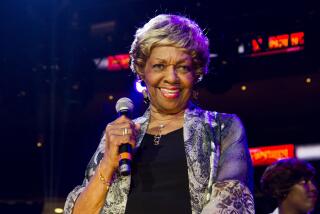The princess and the heiress
- Share via
ADMITTEDLY, there’s something uncanny about the publication of “The Diana Chronicles,” Tina Brown’s book about the princess of Wales, just as America’s own blond headline-grabber, Paris Hilton, was making her way (back) to jail. It makes it too tempting to draw all sorts of parallels between the two women. And we all know who wins that contest.
Anyone tongue-tied at a cocktail party these days can toss out a faux-trenchant quip like “They just don’t make media goddesses like they used to.” It’s not hard to make a case for just how bad Americans have gotten at producing flaxen-haired icons. We like to think we invented the genre -- Jean Harlow, Marilyn Monroe, Grace Kelly. But our more recent blond bombshell types -- not just Paris but Britney and Anna Nicole (it pains me to type these names as much as it pains you to read them) -- seem constructed from ridiculously shoddy materials. If Diana’s persona was cast in pure gold, Hilton et al appear to be made of the quick-drying plaster used for the statues in a Las Vegas casino-hotel.
This approach isn’t merely facile, though, it’s lazy and ultimately dishonest. Diana may have been more dignified, more naturally beautiful and less heavy handed with the peroxide, but she’s also the one who paved the way to fame for Hilton and future generations of the under-talented and overexposed.
As Brown notes in “The Diana Chronicles,” the princess of Wales could manipulate the media with astonishing sophistication and, at times, an appalling lack of scruples. Her participation in Andrew Morton’s book, “Diana, Her True Story,” according to Brown, consisted of the princess more or less spilling her guts and then forcing the author to attribute the information to other sources. Her November 1995 interview with BBC journalist Martin Bashir (the source of the infamous quote, “There were three of us in this marriage”) was, according to Brown, similarly choreographed to elicit maximum public sympathy as well as a divorce from Prince Charles, which the queen requested a month after the broadcast.
Of course, fast forward 10 or so years and these machinations look pretty quaint. In our age of YouTube and camera phones and citizen-generated tabloidism, “media manipulation” is less a learned skill than an involuntary reflex. Diana may seem as anti-YouTube as it gets, but, had she lived, she wouldn’t have been able to resist the undertow of trashy media culture any more than Hilton can.
Sure, Diana would be older, wiser and less likely to forget to put on underwear when she went out. But to hold Diana up as a beacon of decorum while casting Hilton as the poster child for society’s trash problem is to subscribe to the exact fairy tale that got Diana into her royal mess in the first place. The prospect of snagging the prince was, for Diana, the only ambition her family really encouraged. She had a grandmother and two aunts who were royal ladies-in-waiting and a 500-year family legacy of ties to the monarchy. Her prince just turned out to be the sort who remains a frog even after you kiss him.
That faithless marriage and the disapproving monarchy, though, gained Diana something else: a kind of victim status that is simply unavailable to Hilton, or really any contemporary American woman (who, unless she is Hillary Clinton, presumably can get out of her marriage -- and open a pottery studio or write a bestselling tell-all -- if her man betrays her).
Diana, whom Brown characterizes as the winner of “the most endearing airhead ever award,” was no great thinker, either. Like that less-endearing airhead Paris Hilton, who is a high school dropout, Diana’s formal education ended when she was 16. A poor student who would later refer to herself as being “as thick as a plank,” her greatest talent was having her picture taken. “Diana grew up associating the camera with love,” Brown writes, noting elsewhere in the book that “she was way ahead of her contemporaries in foreseeing a world where celebrity was, so to speak, the coin of the realm.”
That’s the realm that Paris Hilton was born into in 1981 -- fittingly, the very same year Diana married Charles. Hilton is now six years older than the Diana who wore that puffy meringue dress in St. Paul’s Cathedral. She’s also, as cultural figures go, not even a fraction as important. But chances are we’d know little about her if Diana hadn’t so rigorously schooled the media and the public in the art of meaningless idol worship.
If Diana was the people’s princess, Hilton is the people’s pariah. And while the princess’ legacy may have led to our current Hilton overdose, that same overdose riled an angry public into demanding Hilton go back to jail. For that small justice, we have Diana to thank.
More to Read
Sign up for our Book Club newsletter
Get the latest news, events and more from the Los Angeles Times Book Club, and help us get L.A. reading and talking.
You may occasionally receive promotional content from the Los Angeles Times.











